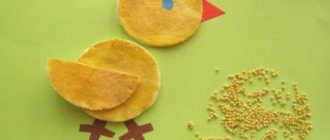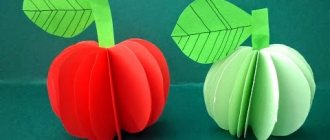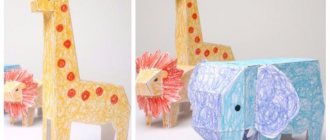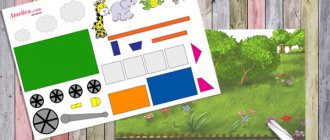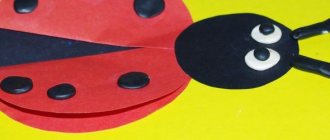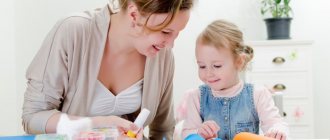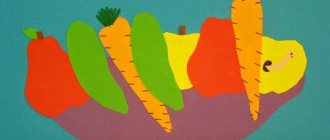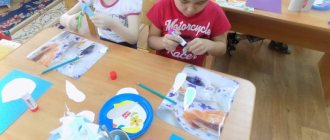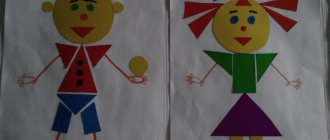DIY application “Locomotive” made of paper for children step by step with photo. Templates
Master class on making a three-dimensional application from cardboard “Locomotive” with step-by-step photos. Tarazanova Elena Borisovna, teacher of additional education, Municipal Budgetary Educational Institution of Preschool Children's and Youth Children's and Youth "Our Harbor", Tomsk Volumetric applique made of cardboard "Locomotive". Step-by-step master class with photos. Goal: to teach how to compose a composition of geometric shapes based on a model. Description: making crafts from paper and cardboard using the applique technique is a very exciting activity. In this type of creativity there is room for your imagination to run wild! Three-dimensional applique expands the creative possibilities of children's works, helps teach a child to think spatially, three-dimensionally; children perceive three-dimensional images better than flat ones. The word applique comes from the Latin “applic”, which means attaching or joining. The appliqué technique is very simple and accessible even to the smallest children, because gluing the parts onto the base is not difficult at all. Purpose: this master class is easy to perform, intended for teachers, educators and parents, as well as for children of preschool and primary school age in classes in kindergarten, school and summer camp. Creative work can be used to decorate a school office, a group in a kindergarten, a home room, for participation in exhibitions and competitions, and also as a gift. Objectives: educational: teach basic geometric concepts: circle, triangle, rectangle, square; learn how to glue ready-made forms; create compositions made using various techniques of working with paper; improve skills in working with the necessary tools and materials when working with paper; learn to complement the image with details that make the craft more expressive; developing: develop interest in appliqué techniques; develop spatial imagination, thinking, ingenuity; develop children's ideas about land transport; develop children's imagination and creativity; develop eye and fine motor skills; educational: cultivate curiosity, accuracy; cultivate diligence when doing work; cultivate interest in creativity. Necessary materials for making an applique: colored and white cardboard, colored paper, felt-tip pens, a simple pencil, a glue stick, scissors, a figured hole punch, a ruler, templates, a sample of the finished product, riddles, poems. Riddles: Iron huts are attached to each other. One of them with a pipe, carries everyone along with her. (Train) This ladder lies, and a locomotive runs along it. (Railroad) Two Snakes turn silver. Shimmering and trembling. The Train rushes through the Snakes, without worrying about anything. (Rails) (V. Struchkov) Poem: A steam locomotive rides, rides, Past the fir trees and birches, Past the morning fields, Past the red bullfinches. Past oak and pine, Past summer and spring. Chug, chug, chug, chug, puffs, And knocks the wheels. Whistling loudly tu-tu-tu, scattering the children. He carries passengers here and there to cities. (Yu. Sklyarova) Necessary templates for making an applique. Using templates, cut out 5 rectangles (locomotive and carriages), a pipe and a roof from colored cardboard. Using shaped hole punches or the necessary templates, make wheels from black paper and windows from yellow paper.
Take half of A-4 size white cardboard. Fold the cardboard in half. This will be the basis for our train; we will glue rectangles of colored cardboard to it.
Glue 1 rectangle horizontally, placing half of the piece on the base. The glue must be applied to the base (white cardboard). Glue 2 rectangles, placing the part vertically (this is the cabin of the locomotive).
Glue all the “carriage” rectangles, trying to align them along the line, leaving the same distance between the carriages. Glue the wheels to the cars. Glue the roof part and the nose to the locomotive. Stick the window on the cabin, and the windows on the cars. Glue the pipe and the eye detail onto the window of the locomotive. Draw a smile, an eye, and use a ruler to draw the rails. Draw grass. If desired, on the reverse side, on white cardboard, you can offer the child to draw passengers (mom, dad, girls, boys, or animals). Steam locomotive for animals Steam locomotive: tuk-tuk, Steam locomotive: each other, Animals in the morning, Takes them to kindergarten: To kindergarten - Tiger Cub. To kindergarten - Little Goat. To kindergarten - a fluffy Yellow chicken. The driver in a cap honks at the Turtle: Today is your fifth carriage, A mustachioed cat is traveling with you. And the seventh carriage is occupied by an Elephant. From wall to wall, that's how wide it is! Steam locomotive: knock-knock, Steam locomotive: each other, Children are going to kindergarten in the morning. (Vladimir Stepanov) Our application is ready! You can play with this train by moving it around the table (it is very stable)! The cheerful little train looks good on a shelf, decorating both your home room and your school office! Creative success!
We recommend watching:
Volumetric applique for children 5-6 years old in kindergarten “Big wash”. Master class with step-by-step photos Volumetric applique with drawing elements for children. Birds on a tree. Master class with step-by-step pho Volumetric application with drawing elements for children 5-7 years old. Master class with step-by-step photos “Crab Application “Rainbow-Arc” made of colored paper for children 5-7 years old. Master class with step-by-step photos
Summary of a lesson on application in the senior group, topic “Train”
Software tasks:
Strengthen the ability to work with paper and glue, create a holistic composition from elements. Develop curiosity, thinking, phonetic hearing, fine motor skills.
Strengthen the ability to cut out the main part of a rectangular object with characteristic features (rounded corners), cut out and paste parts of different shapes.
Practice cutting out objects of the same shape from paper folded like an accordion.
Continue to develop the ability to evaluate created images. Foster respect for the driving profession.
Equipment:
Pictures depicting a variety of vehicles, a road, a sea pier, a railway, an airfield or a sky with clouds. Equipment for application.
Preliminary work:
Transport surveillance. Examination of subject and plot pictures on the topic “Transport”. Conversation, didactic game or lesson about traffic rules.
Progress of the lesson:
Man has come up with many different and interesting professions. Each of you, when you grow up a little, will choose what to do and what profession to choose. In our huge and beautiful village, there is a lot of varied transport, which is staffed by wonderful, helpful people who do not leave you in trouble.
Listen to the riddle:
Riddle about the driver
All the roads are familiar to me, I feel like I’m at home in the cabin. The traffic light is flashing for me, He knows that I am... (Chauffeur)
V. (Yes, these are drivers, chauffeur or, as I also call him),
Children: driver.
Q. What qualities do you think a good chauffeur or driver should have? What should he know and be able to do?
Children's answers: hardworking, kind...
The teacher corrects the children (responsibility, attentiveness, conscientiousness, discipline, hard work, politeness).
But the most important thing is that the driver must know the traffic rules very well, because the safety of both passengers and pedestrians on the roads depends on this. Not only drivers, but also pedestrians must know the rules of the road, and not only know, but always comply with the requirements of these rules. It is very important!
The teacher shows the children all the previously viewed pictures. — How can you describe in one word everything that is depicted in these pictures?
(Children's answers: transport).
B. That's right, transport. There are different types of transport - some fly in the sky, others drive on roads, others sail across the seas and oceans. There is even underground transport - the metro. What types of transport do you know?
Children's answers: (Ground, underground, air, water).
Dynamic pause “Train with cargo”
Children stand in a circle. At a signal, they throw balls to each other (load the wagons). After the command “loading is completed,” children perform movements with their hands (imitating a train ride) with movement in a circle one after another and pronouncing “chuh-chukh-chukh” while exhaling (up to 1 minute). After which the train stops, exhaling “sh-sh-sh” as long as possible. A deep breath is taken through the nose. V. gained strength and began to unload the cars. The balls are passed to the other side.
Q. Guys, I have a cherished dream, to go on a train journey throughout the vast and beautiful Motherland. But I don’t want to go on a trip alone, it’s boring. And I know that I have my little friends - you. And I invite you. Do you agree?
Children: Yes!
V. Guys, we need to go, but we don’t have a train. I want you and I to go on a train like the one I saw, I’ll show you now. But, alas, he is the only one. But, I'll think of something. That's what I came up with.
We will make magic trains with you!
Do you agree?
D. Yes!
Q. Come to our workshop and take a look. Each of you has geometric shapes on the table. Can any of you remind me what they are called? Nikita come and look at them and name them.
Children's answers. (rectangle, square)
B Correct. All these figures will help us in creating our magic trains.
Guys, before we start, let's remember the rules of working with scissors.
Children's answers: (pass the scissors holding them by the blade, do not poke them in the eyes, be careful)
V. Well, let's get started. To begin with, we will cut off the corners of the rectangle and we will get a driver’s cabin, then we will cut off the corners of the remaining 2 rectangles, and we will get cars. Well, from the squares (what do you think we need it for?) we are correct Let's cut out the wheels, also cutting off all the corners.. Rebata, do the cars have windows?
D. Yes!
Then we will fold the square in half, then in half again and cut into equal four parts along the fold line, we will get windows.
B. Now you will place the finished parts on a sheet of paper, and only after everything, we will begin gluing.
V. Guys, what a great fellow you are! Your trains turned out to be very beautiful and durable. Nastya, tell me what shapes you used?
Who will you take with you on your trip?
V.Nikita, tell me, from what shape did you make the wheel?
V. Thank you guys, our workshop today is truly the most magical. And my guys have golden hands!
Thomas the Tank Engine
"Thomas the Tank Engine" is a popular modern cartoon that many children adore. Thomas is made from many materials: from mastic, from candies, and also from paper. We will consider the latter option.
Greetings, dear friends, readers of the Family and Mom blog! Today we have a craft on our website again, and this time we will tell/show the children how to make a train out of cardboard with their own hands for children with step-by-step photo instructions (or rather, from waste/survival material that every mother can find at home - boxes of with juice/milk/kefir).
If your child, like my children, loves everything related to trains/locomotives (the little engine from Romashkovo, Chaggintons and other cartoons with trains are among my children’s favorites), then please him with such a handmade cardboard train, Moreover, its production requires a minimum of time.
In such a homemade train you can carry small toys - Lego men, Kinder Surprise toys and others. A train made of cardboard has windows and a door, almost like a real train. It can be decorated - covered with colored paper, painted with paints, felt-tip pens, but we did not decorate it, since the children urgently needed to carry passengers and they could not wait any longer))
Lesson notes, application “Steam Locomotive”
Abstract
Directly educational activities on the application
On the topic: “Steam locomotive” for older children
Goal: To create conditions for children to consolidate their knowledge and skills in working with paper. Strengthen children's knowledge about ground transport.
Tasks:
Educational:
• consolidate children's ideas about land transport;
• develop the ability to examine objects.
• enrich the sensory world and the ability to record received impressions in speech.
Educational:
• Develop interest in traditional appliqué techniques;
• Develop an aesthetic perception of the environment.
Activate children's speech.
Preliminary work:
A conversation with illustrations about all types of transport - sea, land, air. Examination of toys and paintings - transport, learning outdoor games “Train”, “Planes”. Learning the song “The locomotive is coming, the locomotive is coming”
Materials: Colored paper, scissors, glue, glue brushes, oilcloth lining, rags, paper napkins (white), locomotive template, simple pencil, blue-tinted A4 sheets of paper with a drawn railroad.
Train toy.
Motives for children's activities:
Progress of the lesson
Organizational moment: Children sit on the carpet.
Conversation. What is transport? What kind of transport is there? What is transport needed for? Pay attention to the steam locomotive on the stand and examine it. (What is it like? What carriages? The carriages are carried by a steam locomotive. The locomotive is driven by a driver).
And now you and I will go to class, and for this we will turn into a steam locomotive with carriages. They walk pretending to be a steam locomotive with carriages and sing a song: “The steam locomotive goes, goes, two pipes and a hundred wheels...”
They approach the tables and take their places. Materials for the lesson have already been prepared on the tables.
Guys, we found out what kind of transport there is. Today I invite you to make your own trains. Look, you have steam locomotive templates on your tables, carefully trace them and cut them out. Do you already have the trailers ready, what shape are they? We lay out our train on a sheet of paper.
What is our train missing? (Wheels.) To make it, we need a strip of black paper, divide the strip into squares, and from the squares we make “wheel” circles, smoothly cutting and rounding the corners. (I provide help to children who are experiencing difficulties.)
Warm-up
Finger game "Transport"
Goes for takeoff, goes for takeoff, circular movements with the right hand
propellers rotating the helicopter. above your head
go there, go here showing with straight arms to the right and left
along the ringing train rails. circular movements of the arms along the body
And steamships, ships, arms folded in front of the chest in a triangle
They go to sea from the land. We wave goodbye with our right hand
What else is our train missing? (windows). We take a strip of white paper, fold it in half and in half again, cut along the fold lines, we get white squares. We will use them for windows.
Now we can glue our train.
We glue it carefully onto the railway.
But look, our train cannot go on a journey; its engine does not work, and in order for it to work, it is necessary to glue smoke. We will make smoke from a napkin. We tear off a small piece of napkin, make a lump and glue it opposite the pipe.
All works are exhibited on a stand and examined by children.
Reflection:
-What did we do today?
-What did you guys like today?
Toilet roll train | Kids will have a BLAST with this Fun & East Craft!
Celebrate National Train Day by creating this toilet paper roll ship today!
Train in a Craft Toilet Paper Roll
This train is made from recycled materials , making it an inexpensive craft that's good for the planet! I love making toys with my own hands that keep children occupied long after the craft is completed.
I thought it might be a craft we made and put on display for a while, but I was wrong.
When we finished creating, my son made a train that runs throughout the house for days!
He sat in the kitchen, making her travel around him for a while. His legs, tables and chairs around the house turned into tunnels.
It was a craft activity turned into a toy that resonated with my 3 year old, inspiring hours of imaginative play!
Materials needed to make a toilet paper roll train
This post contains affiliate links.
How to make a train out of toilet paper rolls
- Paint cardboard tubes in different bright colors. Cut C-shapes from one of the tubes to create the top of the engine and galley. Color them accordingly. Also cut a C-shape from a thin cardboard tube and paint it to match the engine color. The C-shaped tubes curve beautifully around the toilet paper roll.
- Once dry, hot glue the top of the engine and galley into place. Also, hot glue four plastic caps onto each cardboard tube for the wheels of your train.
- Make small holes in the four “corners” of each tube. These are your yarn attachment points. Cut the yarn to the desired length.
- Pass the thread through one tube and the other tube to join the two tubes together. To tie a knot. Continue the process until all the train cars are connected.
It's time to play!
Want more T Transportation Activities For Kids?
Try these:
Want more craft ideas using upcycled/upcycled materials?
I can't get enough of crafts that give everyday items a second life!
I hope you enjoyed making a train out of toilet paper rolls! Comment below any craft ideas you have for toilet paper rolls/paper towels!
.
Manigami
From two bills you can make a sampan boat, a type of flat-bottomed boat that is widespread in China. These small boats amaze with their versatility, depending on the needs of the owners, turning into housing, a mobile shop, a fishing “trawler” or a workshop. A sampan made from banknotes will remind you of travels to exotic countries, and it itself looks very unusual. You can also make a sampan boat from paper, focusing on the proportions of a dollar - 15.6x6.6 cm.
Step-by-step instruction:
- Place the bill with the long side facing you. Fold in half from bottom to top. Let's reveal.
- Fold the bottom and top edges towards the center.
- We bend all corners towards the center line.
- We repeat the action again. We make sure that all folds are precise and neat.
Bend the corners again
The edges should lie evenly along the center line. Now fold the triangular flaps at the top and bottom towards the center. We push all the folds along the horizontal axis. Carefully turn the workpiece inside out until the inside becomes a convex bottom.
To make a canopy, just fold another bill in half twice. We insert its ends into the side edges of the boat.
Another traditional Chinese vessel is often assembled using the origami technique. This is a sailing ship known as a junk. Light and maneuverable ships with two or more masts first appeared in the early Middle Ages and have survived almost unchanged to the present day. They can often be found on the rivers of China, as well as neighboring Vietnam and Korea. The junk has unusual sails, which are mats stretched on bamboo yards. They can fold up like window blinds.
A Chinese boat made of paper floats no worse than its real prototype. You can easily verify this by making it yourself, step by step, following the video tutorial:
Color sorting activity
This color sorting activity is a fun way for young children to practice recognizing and sorting colors. My toddler and preschooler loved it!
This post contains affiliate links for your convenience.
This month's featured book for the Children's Virtual Book Club is The Little Engine That Could. My kids love this book!
As you know, I love it when activities can be differentiated to suit the needs of my toddler and my preschooler. To my surprise, this was one of those activities. My toddler loved it, but so did my preschooler!
Necessary materials:
Preparing for the train
- Cut sheets of construction paper in half, except for black.
- Cut out two circles for each carriage from black paper. These will be the wheels.
- Print out a picture of a steam locomotive and draw it on black paper. Then cut it out. You can also draw this by hand on black paper if you are more skilled than me.
- Tidy up the locomotive and carriages on the floor. I would recommend securing each piece with masking tape to prevent them from sliding around like ours did.
- Collect a bunch of little manipulatives and toys in the colors you used for the train cars.
Train color sorting activity
I placed a bunch of manipulatives on the ground next to the train and then encouraged my toddler and preschooler to sort the items into the corresponding cars. My toddler loved doing this. She enjoyed the color combination.
.
Create a masterpiece from plasticine
It's easy to guess what we need for the product. Take modern types of our material. There should be an inscription on the boxes, a small mark “soft”, then the modeling will be pleasant and easy. Make your first plane. For an unusual camouflage, mix a couple of shades of plasticine. Don't forget about the details. We prepare the wings, all sorts of blades, and the body in advance.
Order-star for grandfather
A schoolchild of any grade can make a good, beautiful gift. Using thick paper, cut out a star or a rectangle. Decide on the size yourself, according to your taste. Secure with thread.
Or use wire to decorate with plasticine.
